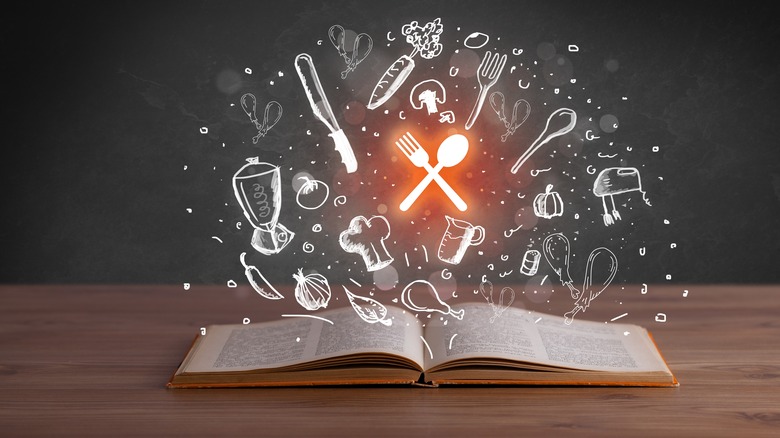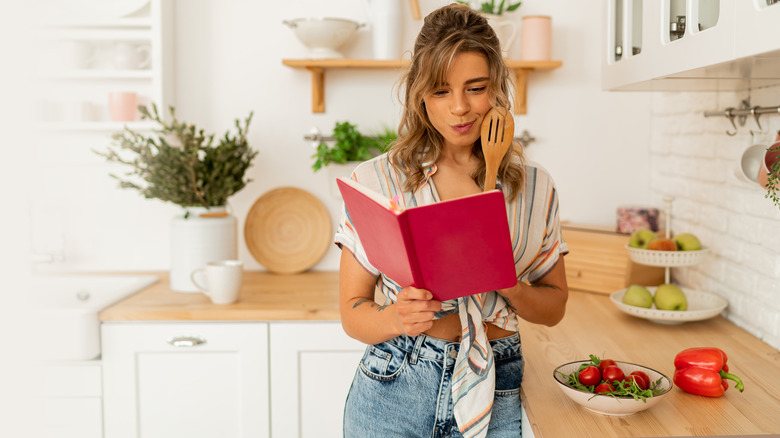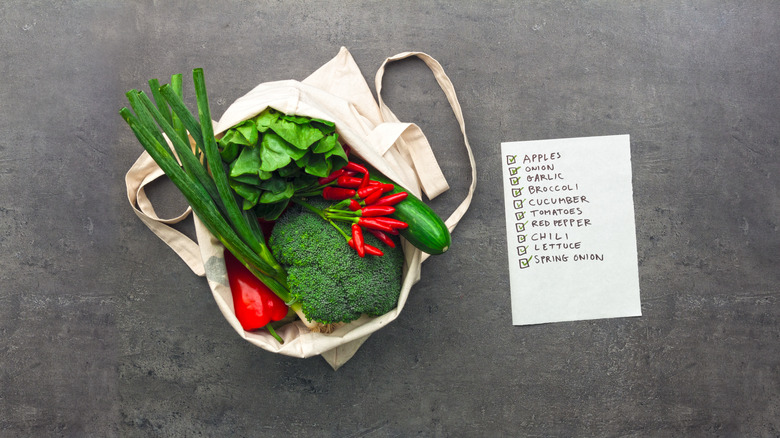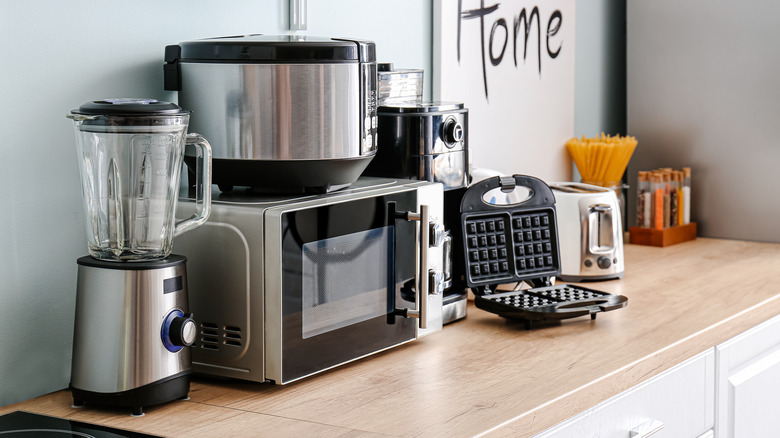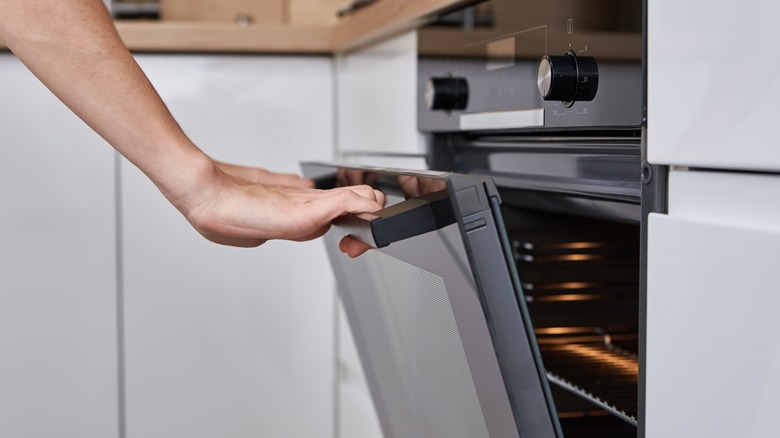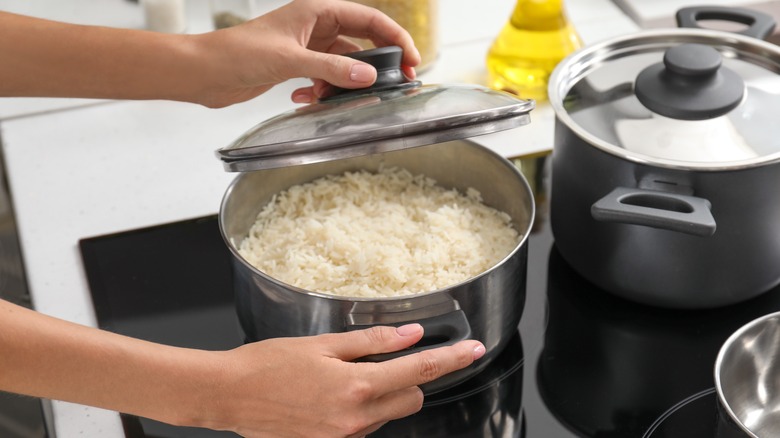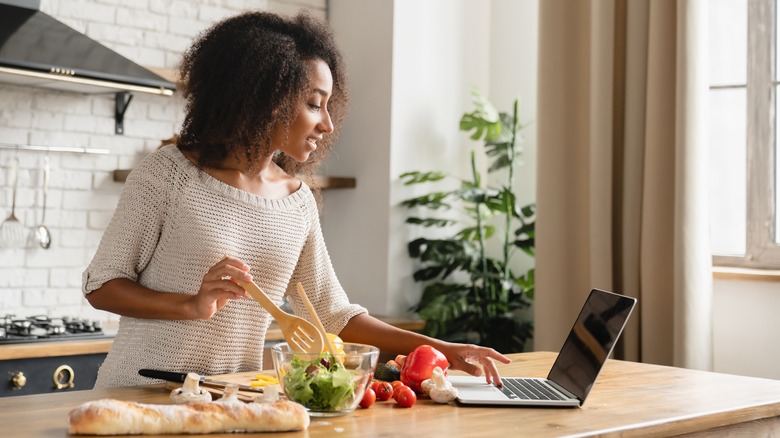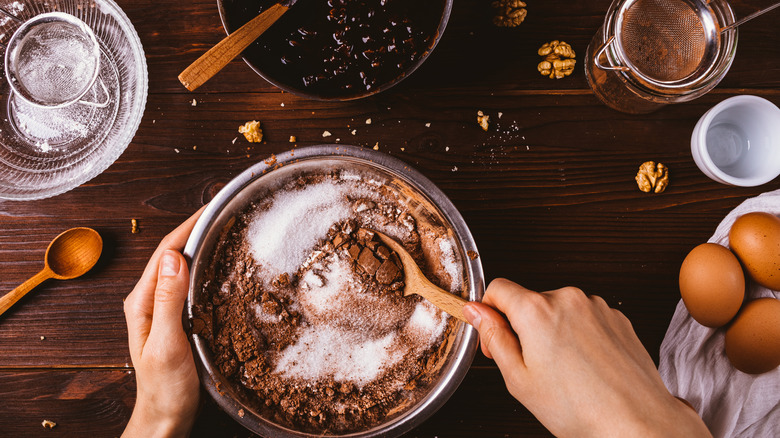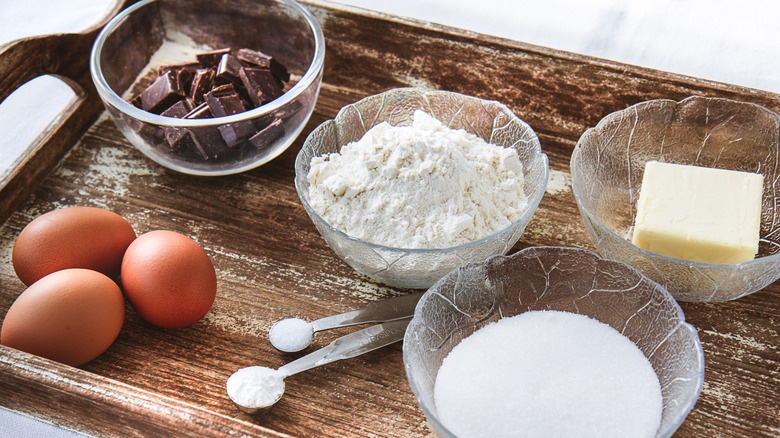12 Tips You Need When Reading A Recipe Before You Cook
Whether they're on a 60-year-old notecard in your grandmother's handwriting, in a celebrity chef's glossy cookbook, or even on your tablet screen after a 15-second Google search, recipes are the blueprints of your meals. They might be passed down through the generations or a brand new creation to adapt to changing dietary trends. They guide even the best chefs and amateurs alike to successful culinary creations. It's essential to approach recipes correctly to get the best results. It might sound laughably simple, but there's actually a process for following a recipe.
You don't need to be a master chef to be able to cook most meals. All you need is the ability to follow the instructions of a recipe. It's easy to rush ahead and skip steps along the way, but if you follow these tips you'll find yourself with plenty of kitchen confidence to tackle any recipe you might come across.
1. Read the recipe all the way through
It sounds like a no-brainer, but the first step of successfully following a recipe is to read the whole recipe through from beginning to end. Do it twice! Before you even turn on your oven, you want to make sure that the recipe is something that you feel comfortable making, have the right ingredients to make, have the time to make, and so on. Take a moment when a recipe catches your eye and read the steps all the way through.
Some recipes are written in a more detailed fashion than others. You might be intimidated by a recipe that has many steps, but you might find, upon reading it, that the recipe's author simply includes a lot of detail in describing the actions. Similarly, another author might include several actions incorporated into one step. Get familiar with how the recipe is laid out for you — that way, you won't be taken by surprise when you get to step eight and it tells you the dough needs to rest for 24 hours.
Reading the recipe ahead of time is also a great way to mentally prepare for the dish that you're making. You can better visualize the end result if you've gone through the recipe a few times and have a holistic picture of the process in your mind.
2. Review the ingredient list
Every recipe will start with a list of ingredients and how much you need of each. Once you've read over the instructions, go back to the ingredient list and review it carefully. Do you have all of the necessary ingredients in your house or do you have to go shopping? Do you or any of your guests have any allergies or food sensitivities that you need to keep an eye out for? You don't want to serve anything that might cause a reaction, so be extra attentive to the presence of common allergens like nuts, dairy, eggs, and gluten. These sorts of ingredients show up in recipes you might not expect.
Ingredient lists will also tell you how much of each ingredient you will need for the recipe. You might know that you have sour cream in your fridge, but do you have two cups' worth? This is the sort of pitfall that can slow you down when you're elbow deep in a recipe and didn't check your supplies ahead of time. You'll also want to check the expiration dates on all your ingredients and make sure that everything is still in-date and ready to be used. That sour cream in your fridge might not be as fresh as you originally thought. Don't sabotage yourself when you've already started. Know what you're going to be working with before you begin.
3. Double check the measurements and their units
While you're checking the ingredients, pay attention to the amounts that you need and how they are being measured. Depending on the recipe, you might find that the recipe is written to have the ingredients measured by volume (cups, teaspoons, tablespoons) or by weight (grams, ounces). Baking recipes, especially, tend to have their ingredients parsed out by weight as most bakers find it to be a more precise form of measurement.
If you find yourself with a recipe that's measured by weight, don't attempt to convert it back to volumetric measurements just by simple division. See if the website or source of the recipe offers a conversion — otherwise, you'll want to bring out your kitchen scale and follow the recipe as it's written. A quarter pound of sugar is not the same as half a cup of sugar. Cooking times and temperatures are affected by measurements, so assume that your recipe has taken that into account.
4. Make sure you have the appropriate amount of time to make the recipe
When you're reading over the recipe, take note of how long the cooking times are, and be sure to factor in the time you need for the prep work as well. You don't want to get halfway through the recipe only to realize that it says you need to braise the meat for three hours and you have your guests arriving in 45 minutes.
Be aware of preparations that always assume a longer amount of time: roasting, braising, and slow-cooking generally require at least an hour's worth of cooking time, not to mention the work you need to do to get the food ready to put into the oven. Also, be aware if the recipe states a certain amount of time per pound of meat. You might skim the recipe and see that you need to cook a large turkey for 15 minutes per pound. If your bird is 10 pounds, you're planning for at least two and a half to three hours of cooking time alone.
5. Check to make sure you have the proper equipment
Besides having the right ingredients and enough time to make your recipe, you want to also ensure that you have the right equipment. There are some kitchen essentials that every home cook needs, like a sharp chef's knife, a sturdy cutting board, and a good pair of tongs. Some recipes, however, call for their own set of specialized tools or equipment.
Sous vide cooking has become popular in recent years, and it's a very specific method of preparing food that requires its own specific cooking device. Similarly, you can't make waffles without a waffle iron. Food processors, immersion blenders, and pressure cookers are also very specific appliances that have uses in their own recipes. So pay attention when you're selecting recipes to what tools are going to be needed. Most recipes will specifically note what sort of equipment you're going to be using in the preparation when the steps are described.
6. See if the oven needs to be preheated
Depending on your oven, it can take some time for it to get up to the cooking temperature that's needed for your recipe. Fortunately, if an oven needs to be preheated, the majority of recipes will include that instruction within the first couple of steps. This might seem like a small detail, but it's actually incredibly important for the success of your dish.
There are several reasons why you want to get your oven preheated. Having the oven at the proper temperature when you've completed all your prep work saves you time. You don't have to wait around for the oven to heat up, let it come to temperature while you're marinating, chopping, or doing other work. It's the easiest of all kitchen multi-tasks. It also ensures that your food will cook evenly once it goes into an oven that's already at a consistent heat.
Sometimes, but not often, you come across a recipe that has you change the temperature part way through the cooking process. This can happen if you're looking to get a steep rise on a muffin top or a glossy shine on a pie crust. Be sure to read the recipe thoroughly to know if and when you would need to alter the cooking temperature.
7. Does the recipe require any prep work before you make the dish?
When you're reviewing your recipe, check to see if there's work that needs to be done before you actually get into the actual process of the meal. For example, fried rice recipes almost always call for rice that has already been cooked and fully cooled, if not chilled overnight in the fridge. Similarly, you might come across recipes that want you to use precooked chicken or other meats as the main component of the meal.
When it comes to this prep work, if the recipe calls for these pre-cooked items, then it is not going to factor in their cooking time to the overall time it takes to make the dish. What is described as a "30-minute dinner" might actually take you much longer if you're starting from scratch with raw components. So pay attention to whether any of the ingredients need to be pre-prepared before you start incorporating them into your dish.
8. See how many servings your recipe yields
How many servings a recipe yields is a crucial piece of information. On most recipes, you will find the yield on the top of the recipe and it will say how many servings or individual portions the recipe will make. Take into consideration how many people you are going to be cooking for or if you want to serve the dish for more than one meal.
Keeping an eye out for the yield will end up saving you time in the long run. You won't find yourself cutting up 12 tomatoes for a recipe just to feed two people, and two chicken breasts wouldn't be enough for a dinner party of six. If the recipe that you're using is for fewer servings than you need, it's often not hard to double or triple the ingredients to get you a higher yield.
Where you start to run into trouble is when it comes to baked goods. Baking is much more temperamental than cooking, so increasing the yield of baking recipes gets tricky. The amount of leavener that is used in a recipe doesn't follow the exact math of simple doubling. When it comes to baked goods, you'll want to look for a recipe that yields specifically the amount that you're looking to make.
9. Don't make any substitutions if it's your first time making a recipe
If it's your first time in recipe club, you have to make the recipe, to paraphrase Tyler Durden. If you've never made the recipe before, you don't know exactly how it's intended to taste or look. You'll want to get comfortable with the bones of it before to start making any changes.
For the most part, recipes are written with the understanding that you'll be using the ingredients that are listed. If you make changes that aren't accounted for in the recipe, then you might end up with a less-than-stellar final product. If you haven't made the recipe before and made substitutions, you might not know whether the substitutions or the recipe itself were to blame for the missteps.
Of course, there are dietary restrictions and allergies to keep in mind, and if you're cooking for someone who has restrictions, you'll want to find recipes that take substitutions into account rather than attempt to change a new recipe to fit the criteria. If a recipe calls for heavy cream and you switch to almond milk, you're going to wind up with a much different result than the recipe intended. Instead of forcing a recipe to conform to restrictions, search out recipes that are designed with the allergens in mind. They will be much more effectively and mindfully tailored to how the substitutions impact the end result.
10. Pay attention to the order of operations
The order in which you do or add things to a recipe can greatly affect the outcome of the meal. There are certain ingredients or processes that are sensitive to how and when they are added and accomplished. Carrots and potatoes take much longer to cook than garlic, which will burn and get bitter if cooked too long. Heartier vegetables need to start cooking first before more delicate ones, and good recipes will lay out exactly when and how you should add each ingredient.
Again, this is where baking is particularly full of pitfalls. In order to get a proper end result with your baked goods, you need to follow the steps exactly in order. Butter and sugar need to be thoroughly creamed before eggs are added. Flour and cocoa should be sifted together as a separate step to ensure they're well-blended and free of lumps. If the steps are taken out of order, then you'll end up with an uneven mess on your hands.
11. Mise en place everything before you begin
The best way to keep yourself organized is a trick that chefs have always used. It's called "mise en place," which literally means "put in place," and it's the simple process of measuring out your ingredients before you start cooking and having them in front of you in small containers so that they can be added quickly and easily as you follow the recipe.
Not only does practicing mise en place keep your ingredients organized, but it keeps your workspace free of clutter and streamlined. It also gets you mentally organized to lay all your ingredients and the tools that you will need out in front of you before you actually start the process of cooking. You're able to double-check that you have the proper ingredients in the proper amounts. You can even line everything up on the counter in the exact order the recipe calls for them so that you can practically add the ingredients with your eyes closed.
Having everything laid out in front of you also prevents simple errors like overlooking or accidentally double-adding an ingredient. It's the culinary equivalent of the "measure twice, cut once" adage.
12. If you're unfamiliar with a term or cooking technique, look it up!
There's no shame in not knowing certain culinary techniques or terms. Half the fun of cooking is expanding your kitchen repertoire and being able to expand your abilities. So what if you've never heard the term "spatchcock"? Don't panic — just look it up!
We, fortunately, live in the age of information. There's a video or website for practically everything (for better or worse). Watching a quick video on how to correctly butterfly a chicken breast is way more efficient than making a guess on how to do it and mangling your proteins. Watching a professional walk you through the process of various techniques might make them more approachable for you instead of just trying to read the description. Even if your end result isn't picture-perfect, like anything else, it's a simple matter of practice, and learning how to perform the correct action early on will set you on the track to refinement.
Just remember that recipes are a guide, a road map to follow. If you follow the directions, you end up where you want to be. The most important part of cooking is enjoying yourself.
